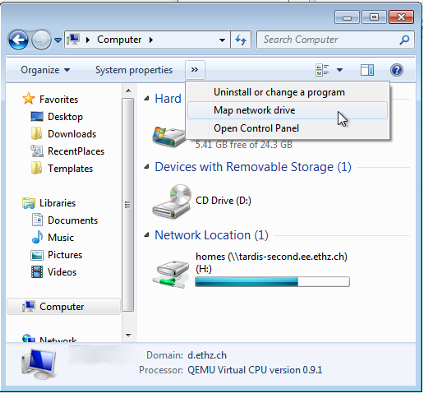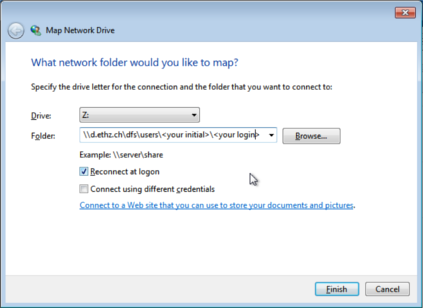|
Size: 1635
Comment:
|
Size: 1635
Comment:
|
| Deletions are marked like this. | Additions are marked like this. |
| Line 26: | Line 26: |
| - The drive letter. Select it from the dropdown list - The path to your homedirectory. This is '''\\d.ethz.ch\dfs\users\<initial_of_your_username>\<your_username>''' e.g. \\d.ethz.ch\dfs\users\t\testuser[[BR]] - Whether you want the drive to reconnect at a later logon. Check or uncheck that checkbox. |
.1) The drive letter. Select it from the dropdown list .2) The path to your homedirectory. This is '''\\d.ethz.ch\dfs\users\<initial_of_your_username>\<your_username>''' e.g. \\d.ethz.ch\dfs\users\t\testuser .3) Whether you want the drive to reconnect at a later logon. Check or uncheck that checkbox. |
Contents
Overview of Mapped Drives
Per default, only one drive is mapped: your homedirectory (H:)
Your Homedirectory at D-ITET (H:)
This is where you should save your data. Your Windows 7 userprofile is also stored on this homedirectory.
A scheduled backup job saves this data every night.
Mapping your Homedirectory provided by ID
If you are a student and use a ISG.EE managed Windows 7 workstation, your homedirectory will be provided by us.
If you still want/need to access the homedirectory you used at Hauptgebäude, you can map it yourself.
Mapping via Windows Explorer
- * Open Windows Explorer, click on "Computer", in the toolbar click on "Map network drive"

- * In the next window, provide the following information:
- 1) The drive letter. Select it from the dropdown list
2) The path to your homedirectory. This is \\d.ethz.ch\dfs\users\<initial_of_your_username>\<your_username> e.g. \\d.ethz.ch\dfs\users\t\testuser
- 3) Whether you want the drive to reconnect at a later logon. Check or uncheck that checkbox.

Mapping via the command line
For mapping the drive via the command line, open the cmd.
Type the following command:
net use * \\d.ethz.ch\dfs\users\<initial_of_your_username>\<your_username> /persistent:yes
This will do the following:
- -The first * will use the last available drive letter to map the drive -The option /persistent:yes will re-map the drive at a later login. Change it to /persistent:no if you do not want that